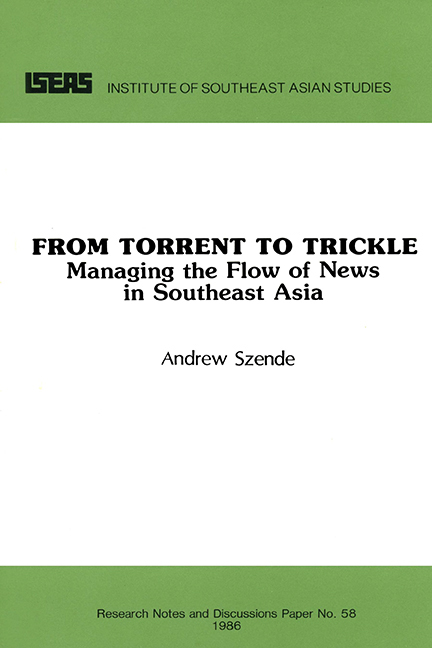Book contents
- Frontmatter
- Contents
- LIST OF TABLES
- Acknowledgements
- PART 1 INTRODUCTION
- PART 2 PERCEPTIONS
- IV The Dilemma of the ASEAN Exchange
- V News Samples in ASEAN
- VI Perceptions of Coverage in ASEAN
- VII Regional Coverage in ASEAN
- PART 3 CONCLUSION
- APPENDIX A
- APPENDIX B
- APPENDIX C
- APPENDIX D
- APPENDIX E
- APPENDIX F
- BIBLIOGRAPHY
- THE AUTHOR
VI - Perceptions of Coverage in ASEAN
from PART 2 - PERCEPTIONS
Published online by Cambridge University Press: 21 October 2015
- Frontmatter
- Contents
- LIST OF TABLES
- Acknowledgements
- PART 1 INTRODUCTION
- PART 2 PERCEPTIONS
- IV The Dilemma of the ASEAN Exchange
- V News Samples in ASEAN
- VI Perceptions of Coverage in ASEAN
- VII Regional Coverage in ASEAN
- PART 3 CONCLUSION
- APPENDIX A
- APPENDIX B
- APPENDIX C
- APPENDIX D
- APPENDIX E
- APPENDIX F
- BIBLIOGRAPHY
- THE AUTHOR
Summary
To a person who works with news, sources are like blood vessels. They carry news not only to the ultimate consumer of the news – the public – but also to other veins and arteries of the system. In fact, it may be argued that there is no ultimate consumer of news in the world, because every consumer is also a potential source. All sources are linked to each other. Of course, there are different kinds of sources, some more important than others, some more frequently used than others. There are virtually no limits to the potential sources that knowledgeable people may use to keep abreast of developments in their community, their country, their region or the world. Obviously, no one has the time, the resources or the ability to keep up with thousands of different sources.
But professionals who work in or have close contacts with the news media do have their favourite sources. To find out what those professionals in ASEAN considered to be their most useful sources in their work, the research for this study included a survey. Even though more than 70 persons were interviewed for the whole study, only 37 of them agreed to reply to the questionnaire; the others did not want to do so. Although this is a relatively small sample, it represents a relatively small universe of perhaps two hundred modest sized organizations in the region. This chapter contains an analysis of the results of the survey, in two parts. The first explores the respondents' perceptions of the most useful (see Table 6.1) and least useful sources of both ASEAN and non-ASEAN news both on a regional and on a country-by-country basis. The second part examines their perceptions about how well those sources are portraying the ASEAN region to the rest of the world and the rest of the world to the ASEAN region.
- Type
- Chapter
- Information
- From Torrent to TrickleManaging the Flow of News in Southeast Asia, pp. 67 - 81Publisher: ISEAS–Yusof Ishak InstitutePrint publication year: 1986

